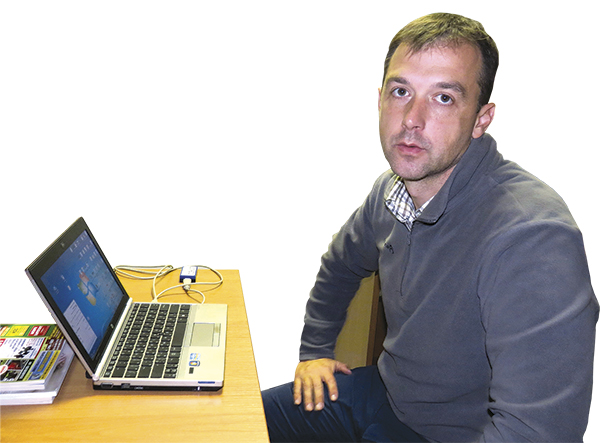
Ecologist Victor Fenchuk is co-ordinating the project, using the latest in GPS-navigating to track wolves. He switches on a computer but hears nothing, telling us “No information has been received for the past four days.” He’s worried but optimistic, believing that the animal is hiding somewhere deep in the forest.
A GPS-navigator is embedded in a collar, operated with help from a mobile operator. It records co-ordinates and transmits them as an SMS message every seven hours. Some time later, a forester can use them to see what the wolf has been doing: sleeping, hunting or eating. The collar weighs around 800g and, after one year, when the battery dies, will fall off, freeing the animal’s neck.
There are only a few places in Belarus where wolves are observed: Polesie Radiation-Ecological Reserve, Berezinsky Reserve and the Pushcha. So far, only one out of 30 Pushcha wolves is collared. National Park staff have placed special traps which do not injure animals, using liquid wax to avoid holding human scent. However, wolves’ sensitive noses have not been thoroughly studied: after a single trapping, these devices have not caught any more animals.

Victor demonstrates a camera which has several times registered animals’ arrival. “We’ve placed cameras in places where traps are situated. However, these animals are cunning and cautious. They sense danger on coming closer, sniff, then move away. We’re now developing a new strategy, wishing to collar four more animals by winter. When the frosts come, we’ll take traps away, to avoid animals catching frostbite in their paws.”
The first wolf — which is now being tracked — was trapped near the village of Shereshevo. He disappeared almost immediately: no message was received for seven days. SMS were then received regularly. After waking up, the animal became used to his collar and recovered from the stress. He spent some time in the corn; as foresters later learnt, eating corpses of wild animals.
The wolf then went to a meliorated field and was tracked to the south of the National Park before moving to the north of the Kamenets District. It waited for something near a Pruzhansky farm, then passed by the Selets water reservoir, moving to Bronnaya Hill, in the Bereza District. The wolf later walked along the road connecting Bereza and Ivatsevichi, and then decided to return to its native Pushcha.
Mr. Fenchuk knows well the wolf’s ‘home’ site but cannot explain its strange walking trajectory. “It’s an interesting wolf,” the man explains. “It doesn’t go deep into the forest, choosing the outskirts of the National Park. It prefers marshes and meliorated canals; where there is much wild fowl, in addition to beavers and roe deer. The wolf spends daytime in the fields. It’s 2-3 years old and seems to be a lone wolf; probably, it doesn’t go into the forest as the territory is already divided.”
Hunters could kill it, as no special permission is now needed, and a fee is even envisaged for culling. “This is right,” agrees Mr. Fenchuk, adding, “We aren’t able to warn everyone about this marked wolf. When the animal went to Pruzhany Forestry, we called local staff. We also informed Sporovsky Reserve when it was heading to the Bereza District. A moratorium on animal culling is temporarily in force in the Belovezhskaya Pushcha for the period of the project.”
It might seem strange that people are interested in studying wolves. There are so many fairy tales and poems about this animal, whose only positive feature seems to be its ‘cleaning’ of the forest. Scientists wish to understand environmental impact on wolves, replenishing knowledge relating to biology, ecology, lifestyle, migration and other aspects of this animal’s life. Data will also be used to realise restoration of wolf populations in Germany, where, for a long time, the animal has been known as extinct.
By Valentina Kozlovich











